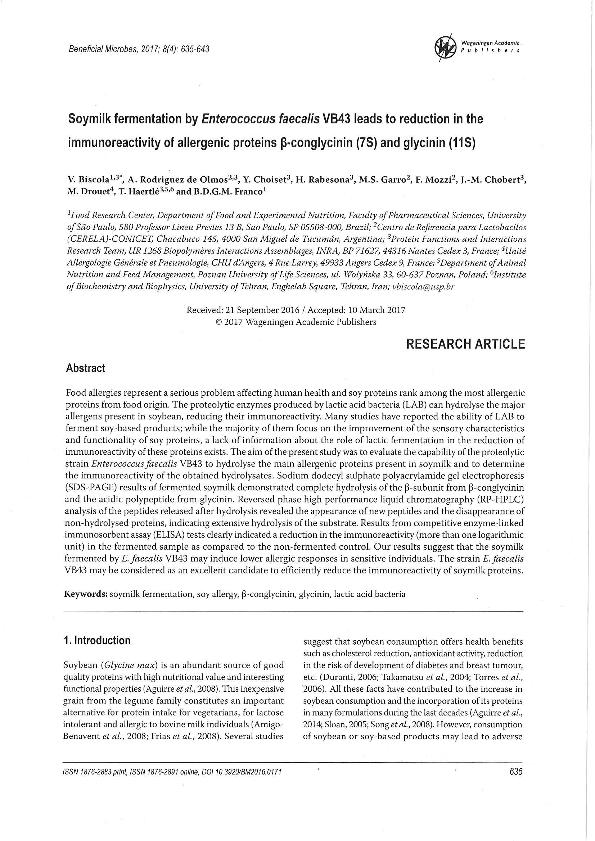Mostrar el registro sencillo del ítem
dc.contributor.author
Biscola, V.
dc.contributor.author
Rodríguez de Olmos, Antonieta

dc.contributor.author
Choiset, Y.
dc.contributor.author
Rabesona, H.
dc.contributor.author
Garro, Marisa Selva

dc.contributor.author
Mozzi, Fernanda Beatriz

dc.contributor.author
Chobert, J. M.
dc.contributor.author
Drouet, M.
dc.contributor.author
Haertlé, T.
dc.contributor.author
Franco, B. D. G. M.
dc.date.available
2018-02-27T16:14:36Z
dc.date.issued
2017-03
dc.identifier.citation
Biscola, V.; Rodríguez de Olmos, Antonieta; Choiset, Y.; Rabesona, H.; Garro, Marisa Selva; et al.; Soymilk fermentation by Enterococcus faecalis VB43 leads to reduction in the immunoreactivity of allergenic proteins β-conglycinin (7S) and glycinin (11S); Wageningen Academic Publishers; Beneficial Microbes; 8; 4; 3-2017; 635-643
dc.identifier.issn
1876-2883
dc.identifier.uri
http://hdl.handle.net/11336/37263
dc.description.abstract
Food allergies represent a serious problem affecting human health and soy proteins rank among the most allergenic proteins from food origin. The proteolytic enzymes produced by lactic acid bacteria (LAB) can hydrolyse the major allergens present in soybean, reducing their immunoreactivity. Many studies have reported the ability of LAB to ferment soy-based products; while the majority of them focus on the improvement of the sensory characteristics and functionality of soy proteins, a lack of information about the role of lactic fermentation in the reduction of immunoreactivity of these proteins exists. The aim of the present study was to evaluate the capability of the proteolytic strain Enterococcus faecalis VB43 to hydrolyse the main allergenic proteins present in soymilk and to determine the immunoreactivity of the obtained hydrolysates. Sodium dodecyl sulphate polyacrylamide gel electrophoresis (SDS-PAGE) results of fermented soymilk demonstrated complete hydrolysis of the β-subunit from β-conglycinin and the acidic polypeptide from glycinin. Reversed phase high performance liquid chromatography (RP-HPLC) analysis of the peptides released after hydrolysis revealed the appearance of new peptides and the disappearance of non-hydrolysed proteins, indicating extensive hydrolysis of the substrate. Results from competitive enzyme-linked immunosorbent assay (ELISA) tests clearly indicated a reduction in the immunoreactivity (more than one logarithmic unit) in the fermented sample as compared to the non-fermented control. Our results suggest that the soymilk fermented by E. faecalis VB43 may induce lower allergic responses in sensitive individuals. The strain E. faecalis VB43 may be considered as an excellent candidate to efficiently reduce the immunoreactivity of soymilk proteins.
dc.format
application/pdf
dc.language.iso
eng
dc.publisher
Wageningen Academic Publishers
dc.rights
info:eu-repo/semantics/openAccess
dc.rights.uri
https://creativecommons.org/licenses/by-nc-sa/2.5/ar/
dc.subject
Glycinin
dc.subject
Lactic Acid Bacteria
dc.subject
Soy Allergy
dc.subject
Soymilk Fermentation
dc.subject
Conglycinin
dc.subject.classification
Alimentos y Bebidas

dc.subject.classification
Otras Ingenierías y Tecnologías

dc.subject.classification
INGENIERÍAS Y TECNOLOGÍAS

dc.title
Soymilk fermentation by Enterococcus faecalis VB43 leads to reduction in the immunoreactivity of allergenic proteins β-conglycinin (7S) and glycinin (11S)
dc.type
info:eu-repo/semantics/article
dc.type
info:ar-repo/semantics/artículo
dc.type
info:eu-repo/semantics/publishedVersion
dc.date.updated
2017-12-04T18:22:50Z
dc.identifier.eissn
1876-2891
dc.journal.volume
8
dc.journal.number
4
dc.journal.pagination
635-643
dc.journal.pais
Países Bajos

dc.description.fil
Fil: Biscola, V.. Universidade de Sao Paulo; Brasil. Centre de Recherche de Nantes. Institut National de la Recherche Agronomique; Francia
dc.description.fil
Fil: Rodríguez de Olmos, Antonieta. Consejo Nacional de Investigaciones Científicas y Técnicas. Centro Científico Tecnológico Conicet - Tucuman. Centro de Referencia Para Lactobacilos; Argentina. Centre de Recherche de Nantes. Institut National de la Recherche Agronomique; Francia
dc.description.fil
Fil: Choiset, Y.. Centre de Recherche de Nantes. Institut National de la Recherche Agronomique; Francia
dc.description.fil
Fil: Rabesona, H.. Centre de Recherche de Nantes. Institut National de la Recherche Agronomique; Francia
dc.description.fil
Fil: Garro, Marisa Selva. Consejo Nacional de Investigaciones Científicas y Técnicas. Centro Científico Tecnológico Conicet - Tucuman. Centro de Referencia Para Lactobacilos; Argentina
dc.description.fil
Fil: Mozzi, Fernanda Beatriz. Consejo Nacional de Investigaciones Científicas y Técnicas. Centro Científico Tecnológico Conicet - Tucuman. Centro de Referencia Para Lactobacilos; Argentina
dc.description.fil
Fil: Chobert, J. M.. Centre de Recherche de Nantes. Institut National de la Recherche Agronomique; Francia
dc.description.fil
Fil: Drouet, M.. Centre hospitalier universitaire d'Angers; Francia
dc.description.fil
Fil: Haertlé, T.. Centre de Recherche de Nantes. Institut National de la Recherche Agronomique; Francia. University Of Tehran; Irán
dc.description.fil
Fil: Franco, B. D. G. M.. Universidade de Sao Paulo; Brasil
dc.journal.title
Beneficial Microbes
dc.relation.alternativeid
info:eu-repo/semantics/altIdentifier/doi/http://dx.doi.org/10.3920/BM2016.0171
dc.relation.alternativeid
info:eu-repo/semantics/altIdentifier/url/http://www.wageningenacademic.com/doi/abs/10.3920/BM2016.0171
Archivos asociados
